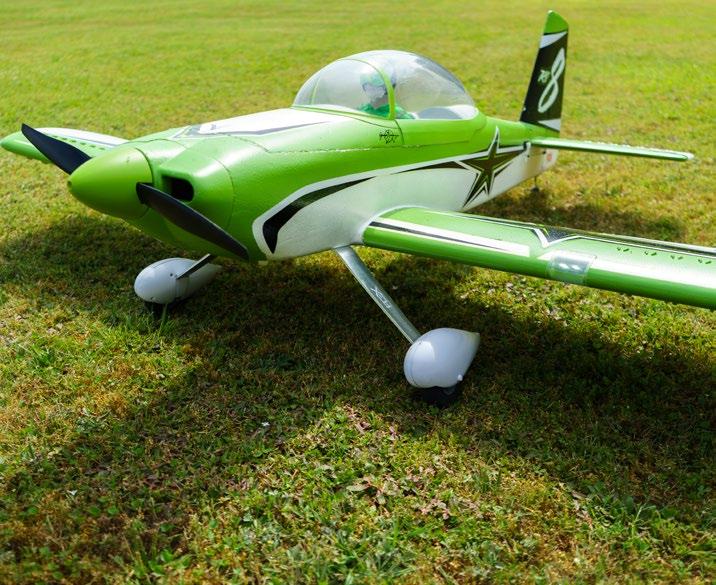
4 minute read
Exploring Precinct 4 from the Sky
story and photos by Crystal Simmons
As a child, Randy Shewmaker built toy airplanes out of junk he found around the house. As he matured, he started experimenting with powered airplanes. "I've been building model powered airplanes since I was about 9," he says. "I was building model parts out of plastic bottles and building stick-and-tissue airplanes that were rubber-band powered. You'd wind them up and they'd go. I got seriously into the RC (radio control) hobby as soon as I could afford it."
Advertisement
By then, it was the 1980s, and he was in his 30s. He'd spend Saturdays at hobby shops ogling the merchandise and imagining the possibilities. As soon as he could, he joined a radio-controlled airplane club. "I started out using an AM radio transmitter, which would probably cost $400 today," he says. "I used to like building kits and my own designs, and now I'm into building scale models. They're miniature representations of real airplanes. Some have a wingspan of 5 to 8 feet."
Shewmaker is part of an increasingly rare breed of model airplane enthusiasts. The activity is like flying a real plane, only arguably more difficult. Instead of moving with the plane, pilots steer from the ground with a remote control.
"You have to be taught to fly (a radio-controlled airplane)," says Shewmaker. "It's difficult, very difficult. It's counterintuitive. When it's going away from you, and you turn it right, it goes right. When it's coming towards you, and you turn it right, it goes left -- and this is happening at 80 to 100 miles per hour. You can't think about it. It has to become instinctual."
The SPARKS RC Club operates from Precinct 4's Dyess Park, one of the few local fields where Shewmaker can practice and the only model aircraft field in Precinct 4.
Unfortunately, as perspectives and habits have changed over the past 40 years, interest in the club has declined. Youth today are more familiar with drones and Amazon than with radio-controlled airplanes and hobby shops, says Shewmaker.
New restrictions on radio-controlled airplanes have also driven away some hobbyists. Because the Federal Aviation Administration doesn't distinguish between model airplanes and drones, users of both devices must fulfill the same requirements, a burden to some enthusiasts.
Now all but most Houston-area hobby shop is closed, and the remaining radio-controlled airplane hobbyists are Shewmaker's age.
With fewer members joining and older members leaving, club membership has dwindled to 55 over the past two years from a high of 120.
The trend isn't unexpected. Millennials and Generation Z came of age during the era of social media, video games, YouTube, and Netflix. Model airplanes represent old technology that doesn't gel with the lifestyles of younger crowds.
Drones, though, set a new standard for the recreational aircraft hobby. When drones hit the market, they quickly picked up steam among the tech-savvy and eventually made their way to mainstream users. The technology revolutionized the way people could experience the world. From then on, those once restricted to the ground could explore areas usually reserved for bats, birds, and insects.
Shewmaker says he understands the appeal.
"They have drone racing competitions through obstacles," says Shewmaker. "The pilots use virtual reality goggles, and there is already a camera on the drone, so they see the world as if they were in the cockpit of an airplane. How do you compete with that?"

"We're certainly wanting to encourage and promote younger people coming to the hobby, and if drones are a way for that to happen, we'd support that," he says.
Cavanaugh hopes drone users could come to appreciate the other side of the hobby. He points out that the radio-controlled airplane hobby can boost intelligence by teaching children about mechanics, physics, wind currents, and electronics, and promote family togetherness. He's seen many children take to the hobby at an early age with the right instruction. "It's a perfect way to get kids interested in STEM (science, technology, engineering, and mathematics)," he says. "I've seen kids as young as 4 or 5 fly radio-controlled airplanes, and they're really good because they have good hand-eye coordination, and they have a parent teaching them."
Most of all, he wants to pass on the skills he has spent decades perfecting.
Cavanaugh says it takes about $300 to get started, but the club offers resources for those interested in trying out the hobby before investing. He says flight simulators are an excellent way to practice without investing in an expensive piece of equipment. "We're willing to help those with an interest," he says. "If you want to come out and learn to fly, we'll find a way to make that happen."
Members fly at the SPARKS RC field on most weekends. For more information, visit sparksrc.com or email president@sparksrc.com or treasurer@sparksrc.com.









